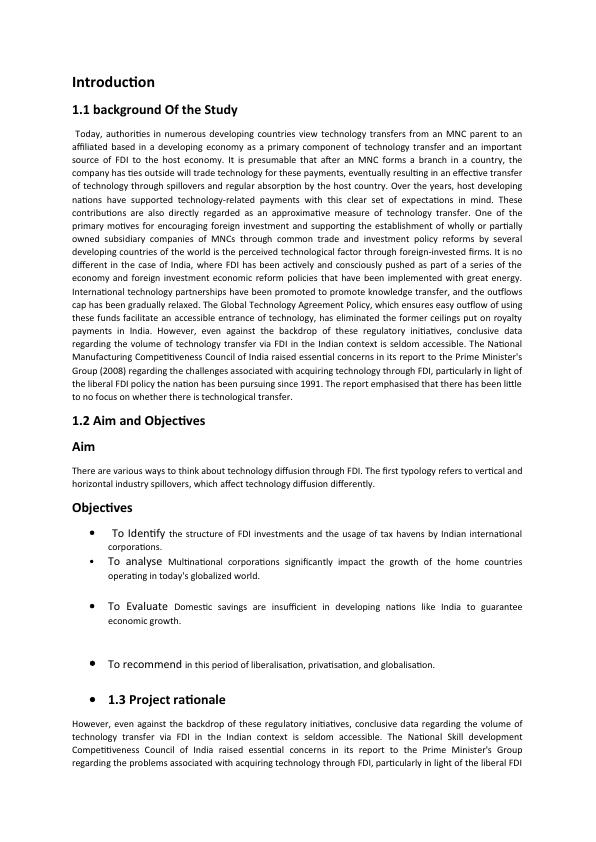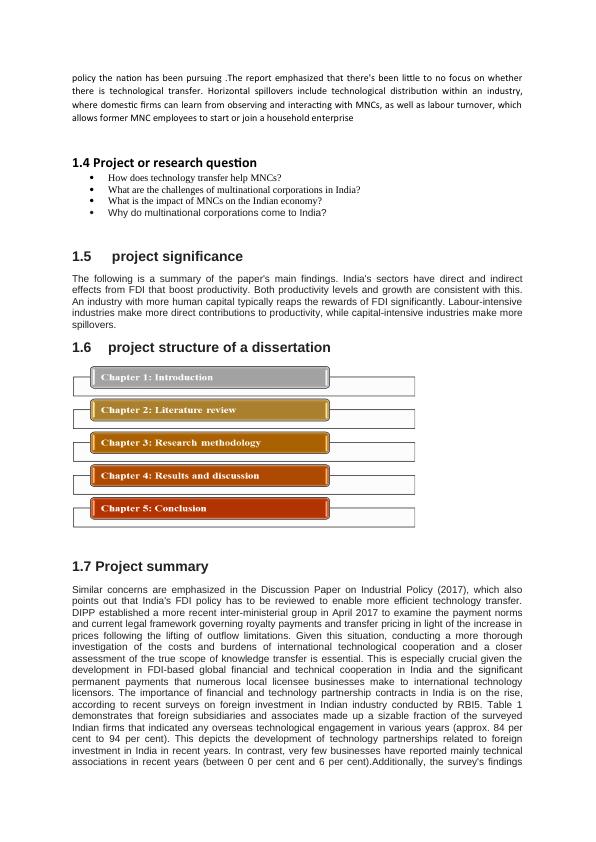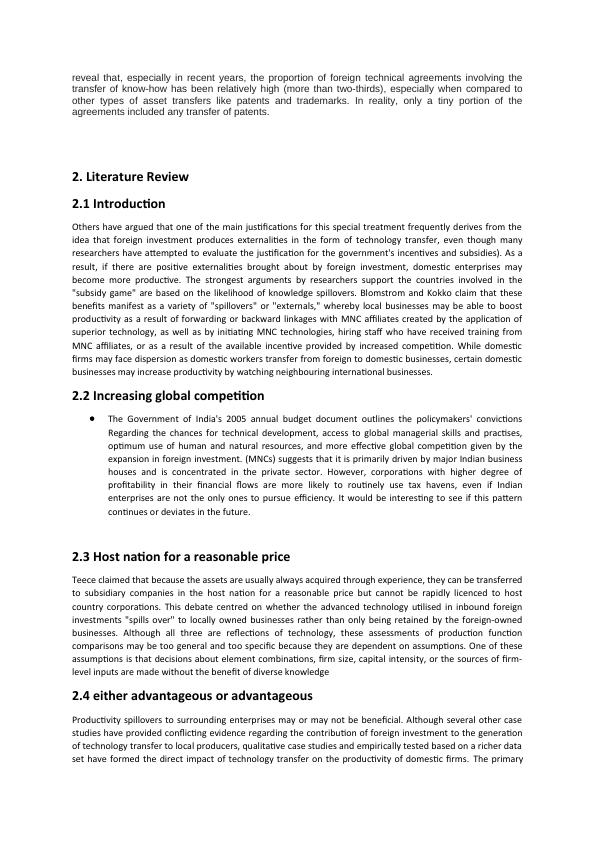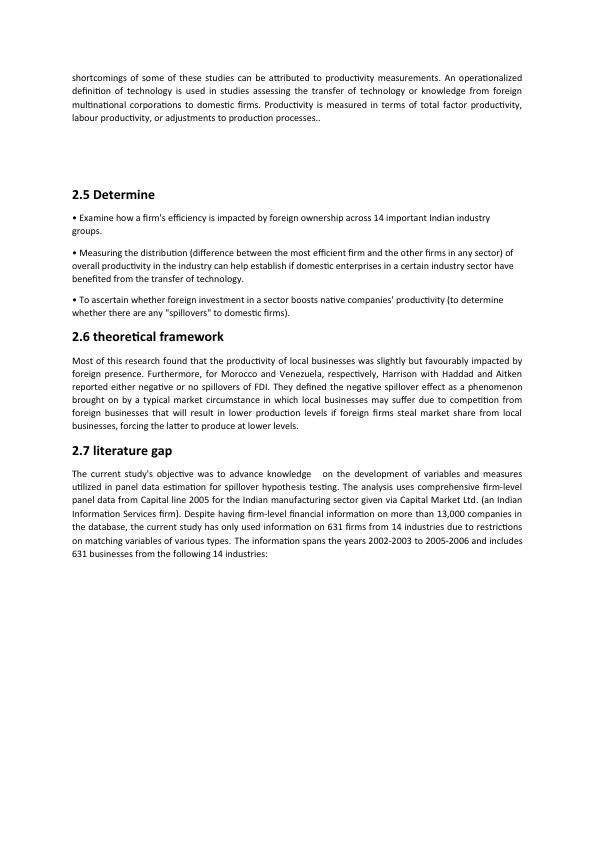Technology Transfer through FDI in India
11 Pages5315 Words22 Views
Added on 2023-01-13
About This Document
This study examines the volume and challenges of technology transfer through FDI in India. It analyzes the impact of multinational corporations on the Indian economy and explores how technology transfer helps these corporations. The study also evaluates the structure of FDI investments and the usage of tax havens by Indian international corporations. The aim is to provide insights into the role of technology transfer in the context of FDI in India.
Technology Transfer through FDI in India
Added on 2023-01-13
ShareRelated Documents
Introduction
1.1 background Of the Study
Today, authorities in numerous developing countries view technology transfers from an MNC parent to an
affiliated based in a developing economy as a primary component of technology transfer and an important
source of FDI to the host economy. It is presumable that after an MNC forms a branch in a country, the
company has ties outside will trade technology for these payments, eventually resulting in an effective transfer
of technology through spillovers and regular absorption by the host country. Over the years, host developing
nations have supported technology-related payments with this clear set of expectations in mind. These
contributions are also directly regarded as an approximative measure of technology transfer. One of the
primary motives for encouraging foreign investment and supporting the establishment of wholly or partially
owned subsidiary companies of MNCs through common trade and investment policy reforms by several
developing countries of the world is the perceived technological factor through foreign-invested firms. It is no
different in the case of India, where FDI has been actively and consciously pushed as part of a series of the
economy and foreign investment economic reform policies that have been implemented with great energy.
International technology partnerships have been promoted to promote knowledge transfer, and the outflows
cap has been gradually relaxed. The Global Technology Agreement Policy, which ensures easy outflow of using
these funds facilitate an accessible entrance of technology, has eliminated the former ceilings put on royalty
payments in India. However, even against the backdrop of these regulatory initiatives, conclusive data
regarding the volume of technology transfer via FDI in the Indian context is seldom accessible. The National
Manufacturing Competitiveness Council of India raised essential concerns in its report to the Prime Minister's
Group (2008) regarding the challenges associated with acquiring technology through FDI, particularly in light of
the liberal FDI policy the nation has been pursuing since 1991. The report emphasised that there has been little
to no focus on whether there is technological transfer.
1.2 Aim and Objectives
Aim
There are various ways to think about technology diffusion through FDI. The first typology refers to vertical and
horizontal industry spillovers, which affect technology diffusion differently.
Objectives
To Identify the structure of FDI investments and the usage of tax havens by Indian international
corporations.
To analyse Multinational corporations significantly impact the growth of the home countries
operating in today's globalized world.
To Evaluate Domestic savings are insufficient in developing nations like India to guarantee
economic growth.
To recommend in this period of liberalisation, privatisation, and globalisation.
1.3 Project rationale
However, even against the backdrop of these regulatory initiatives, conclusive data regarding the volume of
technology transfer via FDI in the Indian context is seldom accessible. The National Skill development
Competitiveness Council of India raised essential concerns in its report to the Prime Minister's Group
regarding the problems associated with acquiring technology through FDI, particularly in light of the liberal FDI
1.1 background Of the Study
Today, authorities in numerous developing countries view technology transfers from an MNC parent to an
affiliated based in a developing economy as a primary component of technology transfer and an important
source of FDI to the host economy. It is presumable that after an MNC forms a branch in a country, the
company has ties outside will trade technology for these payments, eventually resulting in an effective transfer
of technology through spillovers and regular absorption by the host country. Over the years, host developing
nations have supported technology-related payments with this clear set of expectations in mind. These
contributions are also directly regarded as an approximative measure of technology transfer. One of the
primary motives for encouraging foreign investment and supporting the establishment of wholly or partially
owned subsidiary companies of MNCs through common trade and investment policy reforms by several
developing countries of the world is the perceived technological factor through foreign-invested firms. It is no
different in the case of India, where FDI has been actively and consciously pushed as part of a series of the
economy and foreign investment economic reform policies that have been implemented with great energy.
International technology partnerships have been promoted to promote knowledge transfer, and the outflows
cap has been gradually relaxed. The Global Technology Agreement Policy, which ensures easy outflow of using
these funds facilitate an accessible entrance of technology, has eliminated the former ceilings put on royalty
payments in India. However, even against the backdrop of these regulatory initiatives, conclusive data
regarding the volume of technology transfer via FDI in the Indian context is seldom accessible. The National
Manufacturing Competitiveness Council of India raised essential concerns in its report to the Prime Minister's
Group (2008) regarding the challenges associated with acquiring technology through FDI, particularly in light of
the liberal FDI policy the nation has been pursuing since 1991. The report emphasised that there has been little
to no focus on whether there is technological transfer.
1.2 Aim and Objectives
Aim
There are various ways to think about technology diffusion through FDI. The first typology refers to vertical and
horizontal industry spillovers, which affect technology diffusion differently.
Objectives
To Identify the structure of FDI investments and the usage of tax havens by Indian international
corporations.
To analyse Multinational corporations significantly impact the growth of the home countries
operating in today's globalized world.
To Evaluate Domestic savings are insufficient in developing nations like India to guarantee
economic growth.
To recommend in this period of liberalisation, privatisation, and globalisation.
1.3 Project rationale
However, even against the backdrop of these regulatory initiatives, conclusive data regarding the volume of
technology transfer via FDI in the Indian context is seldom accessible. The National Skill development
Competitiveness Council of India raised essential concerns in its report to the Prime Minister's Group
regarding the problems associated with acquiring technology through FDI, particularly in light of the liberal FDI

policy the nation has been pursuing .The report emphasized that there's been little to no focus on whether
there is technological transfer. Horizontal spillovers include technological distribution within an industry,
where domestic firms can learn from observing and interacting with MNCs, as well as labour turnover, which
allows former MNC employees to start or join a household enterprise
1.4 Project or research question
How does technology transfer help MNCs?
What are the challenges of multinational corporations in India?
What is the impact of MNCs on the Indian economy?
Why do multinational corporations come to India?
1.5 project significance
The following is a summary of the paper's main findings. India's sectors have direct and indirect
effects from FDI that boost productivity. Both productivity levels and growth are consistent with this.
An industry with more human capital typically reaps the rewards of FDI significantly. Labour-intensive
industries make more direct contributions to productivity, while capital-intensive industries make more
spillovers.
1.6 project structure of a dissertation
1.7 Project summary
Similar concerns are emphasized in the Discussion Paper on Industrial Policy (2017), which also
points out that India's FDI policy has to be reviewed to enable more efficient technology transfer.
DIPP established a more recent inter-ministerial group in April 2017 to examine the payment norms
and current legal framework governing royalty payments and transfer pricing in light of the increase in
prices following the lifting of outflow limitations. Given this situation, conducting a more thorough
investigation of the costs and burdens of international technological cooperation and a closer
assessment of the true scope of knowledge transfer is essential. This is especially crucial given the
development in FDI-based global financial and technical cooperation in India and the significant
permanent payments that numerous local licensee businesses make to international technology
licensors. The importance of financial and technology partnership contracts in India is on the rise,
according to recent surveys on foreign investment in Indian industry conducted by RBI5. Table 1
demonstrates that foreign subsidiaries and associates made up a sizable fraction of the surveyed
Indian firms that indicated any overseas technological engagement in various years (approx. 84 per
cent to 94 per cent). This depicts the development of technology partnerships related to foreign
investment in India in recent years. In contrast, very few businesses have reported mainly technical
associations in recent years (between 0 per cent and 6 per cent).Additionally, the survey's findings
there is technological transfer. Horizontal spillovers include technological distribution within an industry,
where domestic firms can learn from observing and interacting with MNCs, as well as labour turnover, which
allows former MNC employees to start or join a household enterprise
1.4 Project or research question
How does technology transfer help MNCs?
What are the challenges of multinational corporations in India?
What is the impact of MNCs on the Indian economy?
Why do multinational corporations come to India?
1.5 project significance
The following is a summary of the paper's main findings. India's sectors have direct and indirect
effects from FDI that boost productivity. Both productivity levels and growth are consistent with this.
An industry with more human capital typically reaps the rewards of FDI significantly. Labour-intensive
industries make more direct contributions to productivity, while capital-intensive industries make more
spillovers.
1.6 project structure of a dissertation
1.7 Project summary
Similar concerns are emphasized in the Discussion Paper on Industrial Policy (2017), which also
points out that India's FDI policy has to be reviewed to enable more efficient technology transfer.
DIPP established a more recent inter-ministerial group in April 2017 to examine the payment norms
and current legal framework governing royalty payments and transfer pricing in light of the increase in
prices following the lifting of outflow limitations. Given this situation, conducting a more thorough
investigation of the costs and burdens of international technological cooperation and a closer
assessment of the true scope of knowledge transfer is essential. This is especially crucial given the
development in FDI-based global financial and technical cooperation in India and the significant
permanent payments that numerous local licensee businesses make to international technology
licensors. The importance of financial and technology partnership contracts in India is on the rise,
according to recent surveys on foreign investment in Indian industry conducted by RBI5. Table 1
demonstrates that foreign subsidiaries and associates made up a sizable fraction of the surveyed
Indian firms that indicated any overseas technological engagement in various years (approx. 84 per
cent to 94 per cent). This depicts the development of technology partnerships related to foreign
investment in India in recent years. In contrast, very few businesses have reported mainly technical
associations in recent years (between 0 per cent and 6 per cent).Additionally, the survey's findings

reveal that, especially in recent years, the proportion of foreign technical agreements involving the
transfer of know-how has been relatively high (more than two-thirds), especially when compared to
other types of asset transfers like patents and trademarks. In reality, only a tiny portion of the
agreements included any transfer of patents.
2. Literature Review
2.1 Introduction
Others have argued that one of the main justifications for this special treatment frequently derives from the
idea that foreign investment produces externalities in the form of technology transfer, even though many
researchers have attempted to evaluate the justification for the government's incentives and subsidies). As a
result, if there are positive externalities brought about by foreign investment, domestic enterprises may
become more productive. The strongest arguments by researchers support the countries involved in the
"subsidy game" are based on the likelihood of knowledge spillovers. Blomstrom and Kokko claim that these
benefits manifest as a variety of "spillovers" or "externals," whereby local businesses may be able to boost
productivity as a result of forwarding or backward linkages with MNC affiliates created by the application of
superior technology, as well as by initiating MNC technologies, hiring staff who have received training from
MNC affiliates, or as a result of the available incentive provided by increased competition. While domestic
firms may face dispersion as domestic workers transfer from foreign to domestic businesses, certain domestic
businesses may increase productivity by watching neighbouring international businesses.
2.2 Increasing global competition
The Government of India's 2005 annual budget document outlines the policymakers' convictions
Regarding the chances for technical development, access to global managerial skills and practises,
optimum use of human and natural resources, and more effective global competition given by the
expansion in foreign investment. (MNCs) suggests that it is primarily driven by major Indian business
houses and is concentrated in the private sector. However, corporations with higher degree of
profitability in their financial flows are more likely to routinely use tax havens, even if Indian
enterprises are not the only ones to pursue efficiency. It would be interesting to see if this pattern
continues or deviates in the future.
2.3 Host nation for a reasonable price
Teece claimed that because the assets are usually always acquired through experience, they can be transferred
to subsidiary companies in the host nation for a reasonable price but cannot be rapidly licenced to host
country corporations. This debate centred on whether the advanced technology utilised in inbound foreign
investments "spills over" to locally owned businesses rather than only being retained by the foreign-owned
businesses. Although all three are reflections of technology, these assessments of production function
comparisons may be too general and too specific because they are dependent on assumptions. One of these
assumptions is that decisions about element combinations, firm size, capital intensity, or the sources of firm-
level inputs are made without the benefit of diverse knowledge
2.4 either advantageous or advantageous
Productivity spillovers to surrounding enterprises may or may not be beneficial. Although several other case
studies have provided conflicting evidence regarding the contribution of foreign investment to the generation
of technology transfer to local producers, qualitative case studies and empirically tested based on a richer data
set have formed the direct impact of technology transfer on the productivity of domestic firms. The primary
transfer of know-how has been relatively high (more than two-thirds), especially when compared to
other types of asset transfers like patents and trademarks. In reality, only a tiny portion of the
agreements included any transfer of patents.
2. Literature Review
2.1 Introduction
Others have argued that one of the main justifications for this special treatment frequently derives from the
idea that foreign investment produces externalities in the form of technology transfer, even though many
researchers have attempted to evaluate the justification for the government's incentives and subsidies). As a
result, if there are positive externalities brought about by foreign investment, domestic enterprises may
become more productive. The strongest arguments by researchers support the countries involved in the
"subsidy game" are based on the likelihood of knowledge spillovers. Blomstrom and Kokko claim that these
benefits manifest as a variety of "spillovers" or "externals," whereby local businesses may be able to boost
productivity as a result of forwarding or backward linkages with MNC affiliates created by the application of
superior technology, as well as by initiating MNC technologies, hiring staff who have received training from
MNC affiliates, or as a result of the available incentive provided by increased competition. While domestic
firms may face dispersion as domestic workers transfer from foreign to domestic businesses, certain domestic
businesses may increase productivity by watching neighbouring international businesses.
2.2 Increasing global competition
The Government of India's 2005 annual budget document outlines the policymakers' convictions
Regarding the chances for technical development, access to global managerial skills and practises,
optimum use of human and natural resources, and more effective global competition given by the
expansion in foreign investment. (MNCs) suggests that it is primarily driven by major Indian business
houses and is concentrated in the private sector. However, corporations with higher degree of
profitability in their financial flows are more likely to routinely use tax havens, even if Indian
enterprises are not the only ones to pursue efficiency. It would be interesting to see if this pattern
continues or deviates in the future.
2.3 Host nation for a reasonable price
Teece claimed that because the assets are usually always acquired through experience, they can be transferred
to subsidiary companies in the host nation for a reasonable price but cannot be rapidly licenced to host
country corporations. This debate centred on whether the advanced technology utilised in inbound foreign
investments "spills over" to locally owned businesses rather than only being retained by the foreign-owned
businesses. Although all three are reflections of technology, these assessments of production function
comparisons may be too general and too specific because they are dependent on assumptions. One of these
assumptions is that decisions about element combinations, firm size, capital intensity, or the sources of firm-
level inputs are made without the benefit of diverse knowledge
2.4 either advantageous or advantageous
Productivity spillovers to surrounding enterprises may or may not be beneficial. Although several other case
studies have provided conflicting evidence regarding the contribution of foreign investment to the generation
of technology transfer to local producers, qualitative case studies and empirically tested based on a richer data
set have formed the direct impact of technology transfer on the productivity of domestic firms. The primary

shortcomings of some of these studies can be attributed to productivity measurements. An operationalized
definition of technology is used in studies assessing the transfer of technology or knowledge from foreign
multinational corporations to domestic firms. Productivity is measured in terms of total factor productivity,
labour productivity, or adjustments to production processes..
2.5 Determine
• Examine how a firm's efficiency is impacted by foreign ownership across 14 important Indian industry
groups.
• Measuring the distribution (difference between the most efficient firm and the other firms in any sector) of
overall productivity in the industry can help establish if domestic enterprises in a certain industry sector have
benefited from the transfer of technology.
• To ascertain whether foreign investment in a sector boosts native companies' productivity (to determine
whether there are any "spillovers" to domestic firms).
2.6 theoretical framework
Most of this research found that the productivity of local businesses was slightly but favourably impacted by
foreign presence. Furthermore, for Morocco and Venezuela, respectively, Harrison with Haddad and Aitken
reported either negative or no spillovers of FDI. They defined the negative spillover effect as a phenomenon
brought on by a typical market circumstance in which local businesses may suffer due to competition from
foreign businesses that will result in lower production levels if foreign firms steal market share from local
businesses, forcing the latter to produce at lower levels.
2.7 literature gap
The current study's objective was to advance knowledge on the development of variables and measures
utilized in panel data estimation for spillover hypothesis testing. The analysis uses comprehensive firm-level
panel data from Capital line 2005 for the Indian manufacturing sector given via Capital Market Ltd. (an Indian
Information Services firm). Despite having firm-level financial information on more than 13,000 companies in
the database, the current study has only used information on 631 firms from 14 industries due to restrictions
on matching variables of various types. The information spans the years 2002-2003 to 2005-2006 and includes
631 businesses from the following 14 industries:
definition of technology is used in studies assessing the transfer of technology or knowledge from foreign
multinational corporations to domestic firms. Productivity is measured in terms of total factor productivity,
labour productivity, or adjustments to production processes..
2.5 Determine
• Examine how a firm's efficiency is impacted by foreign ownership across 14 important Indian industry
groups.
• Measuring the distribution (difference between the most efficient firm and the other firms in any sector) of
overall productivity in the industry can help establish if domestic enterprises in a certain industry sector have
benefited from the transfer of technology.
• To ascertain whether foreign investment in a sector boosts native companies' productivity (to determine
whether there are any "spillovers" to domestic firms).
2.6 theoretical framework
Most of this research found that the productivity of local businesses was slightly but favourably impacted by
foreign presence. Furthermore, for Morocco and Venezuela, respectively, Harrison with Haddad and Aitken
reported either negative or no spillovers of FDI. They defined the negative spillover effect as a phenomenon
brought on by a typical market circumstance in which local businesses may suffer due to competition from
foreign businesses that will result in lower production levels if foreign firms steal market share from local
businesses, forcing the latter to produce at lower levels.
2.7 literature gap
The current study's objective was to advance knowledge on the development of variables and measures
utilized in panel data estimation for spillover hypothesis testing. The analysis uses comprehensive firm-level
panel data from Capital line 2005 for the Indian manufacturing sector given via Capital Market Ltd. (an Indian
Information Services firm). Despite having firm-level financial information on more than 13,000 companies in
the database, the current study has only used information on 631 firms from 14 industries due to restrictions
on matching variables of various types. The information spans the years 2002-2003 to 2005-2006 and includes
631 businesses from the following 14 industries:

End of preview
Want to access all the pages? Upload your documents or become a member.
Related Documents
Global Business And Sustainability Contentslg...
|11
|3824
|15
International Business Assignment Samplelg...
|9
|4694
|354
Foreign Direct Investment in Indialg...
|9
|2897
|410
Foreign Direct Investment (FDI) In India | Assignmentlg...
|15
|3277
|238
Foreign Direct Investment in Indialg...
|13
|3176
|257
Foreign direct investment (FDI) Assignmentlg...
|5
|1822
|225
